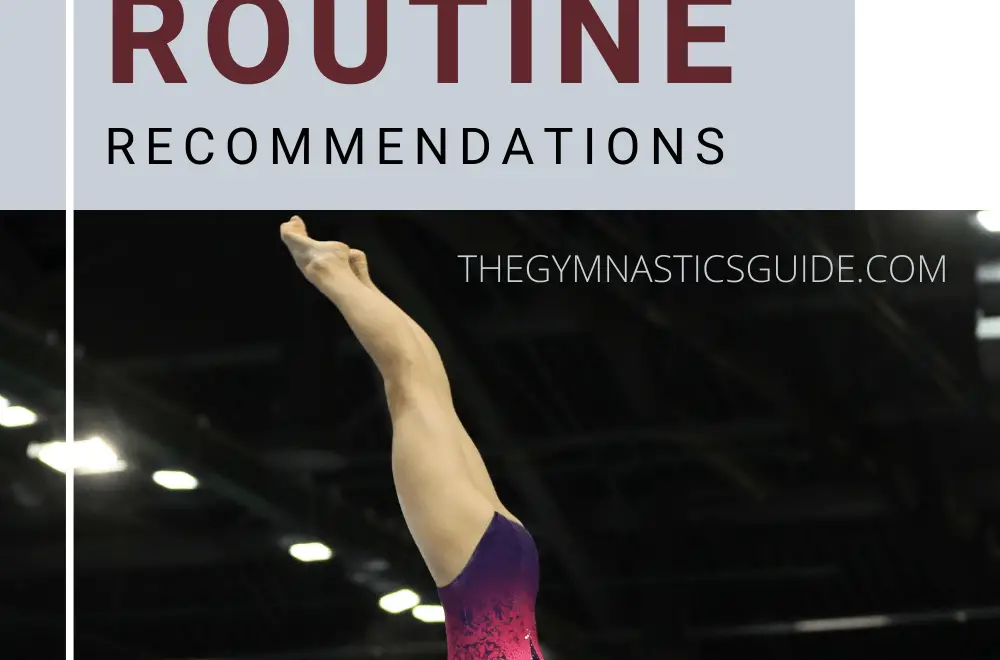This post has been updated to reflect the 2022-2026 Code of Points.
Introduction to Level 7 Bars
For a gymnast with a strong Level 6 bar routine, the transition to Level 7 bars isn’t too tough. But without a basic knowledge of casting and circling technique, it’s a challenge to get a big score! The requirements for a Level 7 bar routine are slightly tougher – gymnasts must cast higher, and perform an extra circle. Let’s take a look at how these requirements play out.
Philosophy Behind Level 7
The idea behind Level 6 and 7 gymnastics is to ease gymnasts into the optional levels, without the need to perform difficulty beyond the level’s requirements. For this reason, there are no composition deductions in these two levels. Composition deductions are deductions taken at the end of the routine, based on the construction of the routine. They can include deductions for lack of difficulty, too many common transitions, or failure to include certain skills in the routine.
In Level 6 and 7, these deductions are NOT applied. The goal is to create routines that meet the requirements and are performed as cleanly as possible. Often, the highest scoring routines are those that include the bare minimum number of skills, performed very well. There are general deductions that are taken at the end of the routine, such as rhythm and dynamics, and these deductions are still applied. But there’s no need to worry about exceeding the difficulty requirements. Just do what you can do well, and be done!
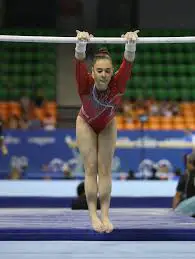
Value Parts for a Level 7 Bar Routine
Level 7 gymnasts need 5 A skills and 2 B skills on each event (bars, beam, and floor). All skills in gymnastics are evaluated based on their difficulty level, and they are given a value from A through E. A skills are the easiest, while B skills are a bit more difficult. The gymnast is allowed to choose the skills that she can perform the best in each of these difficulty categories. Each A skill is worth 0.10, and each B skill is worth 0.30. Deductions are taken off the Start Value if a skill is missing.
Examples of B skills on bars include:
- Clear hip circle
- Toe circle to clear support
- Stalder to clear support
- Cast handstand
- Giant
- Flyaway ½ or 1/1
It’s important to note that casts below handstand have no value. If you’re counting on a cast handstand for a Value Part, and the cast falls short, you’ll be missing a skill.
There are just a handful of allowable “C” skills in Level 7, and they all receive “B” credit if performed:
- Clear hip circle to handstand
- Clear hip circle to handstand ½ pirouette to regular grip
- Stalder to handstand
- Stalder to handstand ½ pirouette to regular grip
- Toe circle to handstand
- Toe circle to handstand ½ pirouette to regular grip
- Cast handstand ½ pirouette
The gymnast may perform as many allowable “C” skills as she would like in her Level 7 bar routine. Any unallowable C’s, along with any D or E elements, will result in a 0.50 deduction from the Start Value for a restricted skill.
Special Requirements for a Level 7 Bar Routine
There are four Special Requirements for a Level 7 bar routine. Each Special Requirement is worth 0.50 off the Start Value.
The Special Requirements are as follows:
- Cast 45° above horizontal
- 360° clear circling skill, minimum “B” value
- 360° clear circling skill from group 3, 6, or 7
- “A” salto dismount
Here is more detail on each of these Special Requirements.
Cast
If you read the Code of Points, the Level 7 casting requirement can be confusing to interpret. It reads, “One cast to handstand (SR awarded when angle is a minimum of 45°). Then it mentions angle deductions, which are applied if the cast is below 20° from vertical.
What you really need to know is this: you’ll get Special Requirement credit if the cast is 45° above horizontal. Amplitude deductions apply for any cast below 20° from vertical. The cast can fulfill the Special Requirement even if it is not awarded Value Part credit.
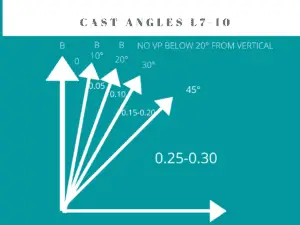
Now, how do judges determine the angle of the cast?
There are two main concepts to know when determining cast angles.
First, the angle is measured from the shoulders to the lowest body part. This means that if the gymnast is arched, the angle is measured from her shoulders to her belly. If she is piked, it’s the angle from her shoulders to her feet. If she has a straight body, the measurement goes straight down the length of her body. It’s important to critically evaluate the gymnast’s body shape when determining the angle of her cast.
Second, a straddle cast is considered complete when the feet join together. In a straddle cast, it’s common to see the hips rise to meet the requirement, but then lower again by the time the feet close. In this case, the gymnast would not get credit for the higher cast she appeared to have achieved, because the cast was incomplete until her feet came together.
Even if the gymnast meets her Special Requirement of a cast above 45°, she still may receive amplitude deductions on the cast. If the cast is below 20°, an up to 0.30 deduction can be applied.
For more information about angles on bars, see What’s Your Bar Angle?
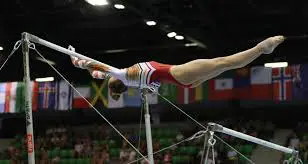
360° circling skill from Group 3/6/7
The gymnast must perform a clear 360° circling skill from one of the following Groups: 3, 6, or 7. If you’re not familiar with these groups, they are the clear hip, stalder, and toe circle/sole circle groups.
There is NO amplitude requirement to receive credit for the circling skill, but the skill must finish with the hips clear of the bar. Make sure it’s obvious that the hips aren’t touching the bar. Even if the gymnast doesn’t put support on her hips, if the judge sees the hips touching the bar at the end of the circle, it will get lower Value Part credit (A instead of B) and no Special Requirement credit.
If the gymnast attempts to perform a circle to handstand, and falls back over, she will get credit for the circle if she reaches within 20° of handstand. If she opens earlier than that, she’ll want to repeat the skill in order to get Value Part and Special Requirement credit.
Here you can see the angle charts for circling skills. These charts determine the amplitude deductions that apply to each circling skill. Remember that execution deductions such as bent arms, bent legs, arched or piked body position, and leg separations are taken in addition to amplitude deductions.
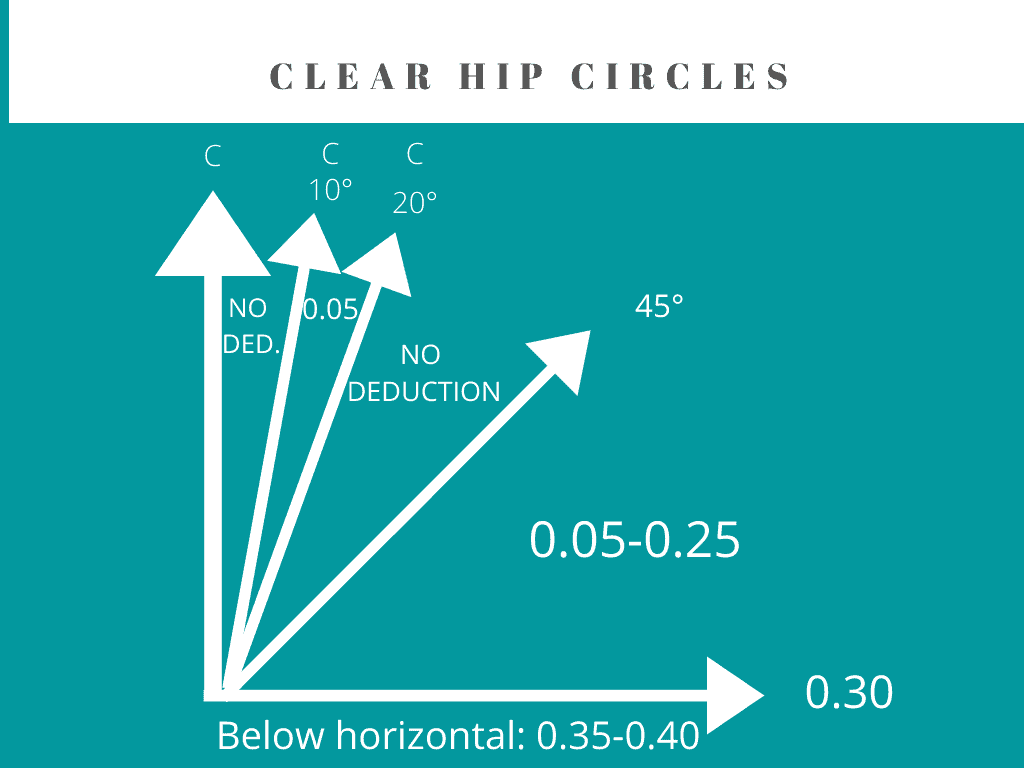
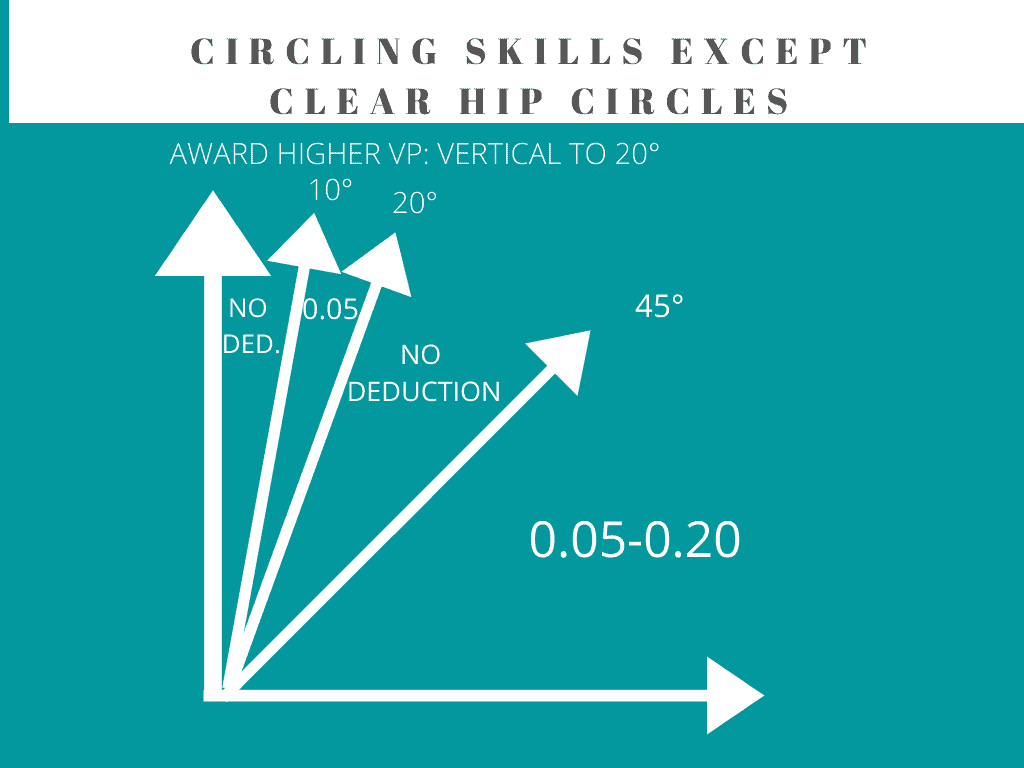
360° circling skill, minimum “B” value
This circling skill can be the same or different than the first circling skill. Some gymnasts will perform a second clear hip circle to meet this requirement. If a second clear hip circle (or stalder/toe circle) is performed, it must be in a different connection than the first. A different connection means that the skill is preceded or followed by a different skill. Here’s an example:
Kip, cast horizontal, clear hip circle, kip, cast 45°, clear hip circle, kip, squat on
Both of these casts fall short of handstand, so they are considered the same skill. Because of this, both clear hip circles are preceded by a cast of no value, and followed by a kip. This makes them the SAME, and the second one would get NO value part credit.
Here’s another example:
Kip, cast 45°, clear hip circle, kip, squat on, long hang kip, cast 45°, clear hip circle, long hang kip, cast, flyaway
In this example, the skill preceding the clear hip circle is the same in both instances, but the exit skill is different. Low bar kip and long hang kip have different numbers in the Code of Points, so they are considered different skills. Both of these clear hip circles would get credit, and both Special Requirements would be awarded.
It’s also been clarified that performing a cast to handstand (B) into a skill, then performing a short cast (No Value Part) into the same skill, will be considered two different entrances, therefore allowing the skill to receive Value Part credit twice.
The circling skill in this Special Requirement does not need to be from Groups 3, 6, or 7. This means that it could also be fulfilled by a giant, which is a B value circling skill. The only other skills from other groups that would meet this requirement are low bar front giants, or a low bar giant ½. I’ve personally never seen them performed by a Level 7 gymnast, likely because they are much less progressive than a regular high bar giant, or a second circling skill from Group 3, 6, or 7.
“A” salto dismount
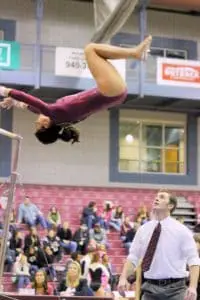
The gymnast can perform any “A” or “B” salto dismount to get credit for this Special Requirement. The salto can be backward or forward, with or without a twist. Common salto dismounts are tuck and layout flyaways.
As long as the gymnast lands on her feet first, she will receive credit for her dismount. If she does not land feet first, she will not get Special Requirement credit. Depending on how much of the dismount she completes, she may also receive a 0.30 deduction off the Start Value for no dismount.
Common Deductions for a Level 7 Bar Routine
In Level 7, the emphasis is on performing basic skills with excellent technique, to prepare for the higher levels. The routines that meet the requirements, with the cleanest execution, are the ones that will finish on top. In addition, these gymnasts will be the best prepared to move into Level 8 and beyond. What do I mean by “clean execution”? A gymnast with clean execution has minimal form deductions.
Here are some of the most common deductions that can occur during a Level 7 bar routine. These deductions are assessed each time they occur.
Common deductions include:
- Foot form – 0.05
- Poor rhythm – up to 0.10
- Brush/touch of apparatus or mat with feet – up to 0.10
- Poor body position – up to 0.20
- Leg separation – up to 0.20
- Bent arms – up to 0.30
- Bent knees – up to 0.30
- Extra swing – 0.30
- Hit on mat with feet – 0.30
- Fall – 0.50
Final Thoughts
The best Level 7 bar routines are short, sweet, and well executed. The top Level 7 gymnasts will have strong casting and circling skills. These gymnasts will show good body shaping throughout the routine. In general, the fewer skills the better – many of the top routines do the majority of their skills on the high bar, although this isn’t necessary to get a high score. Great Level 7 bar routines look like they are floating, and they are really fun to watch!
Further Reading
Tips and Resources for Level 6/7 Vault
Guide to Choosing Gymnastics Grips
Level 6 Bar Routine Recommendations
The Ideal Composition for a Level 8 Bar Routine
The Ideal Composition for a Level 9 Bar Routine
The Ideal Composition for a Level 10 Bar Routine
References
USA Gymnastics J.O. Code of Points, 2022-2026.
